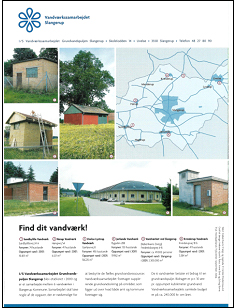 |
 |
 |
 |
 |
 |
 |
 |
 |
 |
 |
 |
Project description
Name of the case study
Developing new methods for co-operation on groundwater protection: Water co-operation and project "Clean Water".
Description of context
In 1998 the Water Extraction Act enabled the water suppliers to pose a fee on water to establish water co-operations and strengthen groundwater protection – the so-called groundwater funds. Also, the counties were given permission to impose a duty for groundwater protection. It became possible to establish a formal collaboration ("Water Co-operations") with local water works and others with an interest in groundwater protection around the catchment sites.
The co-operation is embedded in existing regulation of the water sector, including monitoring programs for the aquatic environment (for instance the "National Program for Surveillance of the Aquatic Environment", NOVA, running from 1998-2003)
Description of project - background

Map showing the geographical extension of the Water Co-operation in Slangerup, and the local waterworks involved
Traditionally tasks in water supply management, including groundwater use, - catchments, and –protection is normally divided between different actor-groups, including consumers, regional water providers (Copenhagen Water), local water providers (small waterworks), local users of the land (farmers, private well owners etc.). The water cooperation enables coordinated initiatives towards protecting the groundwater between these actors (see illustration above). This specific cooperation (between Copenhagen Energy and the local stakeholders in Slangerup municipality), has included a number of different initiatives to protect the groundwater in the municipality of Slangerup, which is one of the main groundwater catchment areas for Copenhagen Energy.
One of the main initiatives has been aimed at closing private wells and drillings that are not used. The municipality has made a registration of all wells and drillings, which amounted in more than 200. These are seen as "open wounds" that leads pollution directly to the groundwater – e.g. some wells has been used by farmers as a deposit for used empty packaging from pesticides. Generally, pollution from point-sources has been underestimated, but newer research shows that the groundwater is very vulnerable for pollution from such sites; therefore it is taken very serious in the water co-operation. The municipality can force people to close a well, but as this can be very difficult they prefer if the owner closes his well voluntary.
Other initiatives are a campaign for avoiding pesticides in private gardens, and the possibilities for farmers to have free consultancy about their practices with pesticides. A future tasks is to buy up fields of special interest for groundwater protection in order to relay the use – e.g. to organic farming, forest or fallow.
Description of project - objectives/aims
The main issue is related to groundwater protection
Description of project - time interval and stages
The cooperation started in 2001, there is no expected end date
Description of project - financing
The cooperation is financed through the "groundwater funds"
Description of project - other sectors involved
Groundwater protection is related to land use (agriculture, nature, industry, recreation etc.), as this influences the pollution of the groundwater.
What tools were used to assess sustainability?
Water co-operation
More information